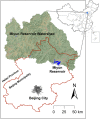Benefits, costs, and livelihood implications of a regional payment for ecosystem service program
- PMID: 24003160
- PMCID: PMC3799363
- DOI: 10.1073/pnas.1312324110
Benefits, costs, and livelihood implications of a regional payment for ecosystem service program
Abstract
Despite broad interest in using payment for ecosystem services to promote changes in the use of natural capital, there are few expost assessments of impacts of payment for ecosystem services programs on ecosystem service provision, program cost, and changes in livelihoods resulting from program participation. In this paper, we evaluate the Paddy Land-to-Dry Land (PLDL) program in Beijing, China, and associated changes in service providers' livelihood activities. The PLDL is a land use conversion program that aims to protect water quality and quantity for the only surface water reservoir that serves Beijing, China's capital city with nearly 20 million residents. Our analysis integrates hydrologic data with household survey data and shows that the PLDL generates benefits of improved water quantity and quality that exceed the costs of reduced agricultural output. The PLDL has an overall benefit-cost ratio of 1.5, and both downstream beneficiaries and upstream providers gain from the program. Household data show that changes in livelihood activities may offset some of the desired effects of the program through increased expenditures on agricultural fertilizers. Overall, however, reductions in fertilizer leaching from land use change dominate so that the program still has a positive net impact on water quality. This program is a successful example of water users paying upstream landholders to improve water quantity and quality through land use change. Program evaluation also highlights the importance of considering behavioral changes by program participants.
Keywords: regional collaboration; social-ecological systems; sustainability; sustainable household livelihoods; watershed management.
Conflict of interest statement
The authors declare no conflict of interest.
Figures




Comment in
-
Integrated assessments of payments for ecosystem services programs.Proc Natl Acad Sci U S A. 2013 Oct 8;110(41):16297-8. doi: 10.1073/pnas.1316036110. Epub 2013 Sep 26. Proc Natl Acad Sci U S A. 2013. PMID: 24072648 Free PMC article. No abstract available.
References
-
- Engel S, Pagiola S, Wunder S. Designing payments for environmental services in theory and practice: An overview of the issues. Ecol Econ. 2008;65(4):663–674.
-
- Dasgupta S, Hamilton K, Pagiola S, Wheeler D. Environmental economics at the World Bank. Rev Environ Econ Policy. 2008;2:4–25.
-
- Wunder S, Engel S, Pagiola S. Taking stock: Lessons learnt for the design of payment for environmental sciences programs. Ecol Econ. 2008;65:834–852.
-
- Vincent JR. Microeconomic analysis of innovative environmental programs in developing countries. Rev Environ Econ Policy. 2010;4(2):221–233.
-
- Xu Z, Bennett MT, Tao R, Xu J. China’s Sloping Land Conversion Program four years on: Current situation and pending issues. Int Forest Rev. 2004;6:317–326.
Publication types
MeSH terms
Substances
LinkOut - more resources
Full Text Sources
Other Literature Sources

